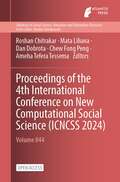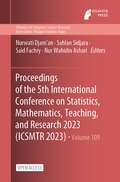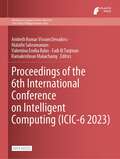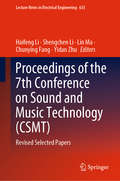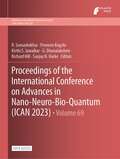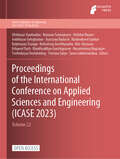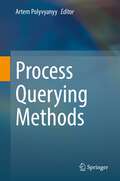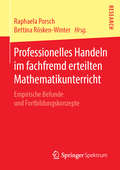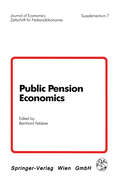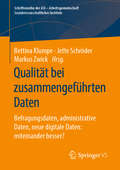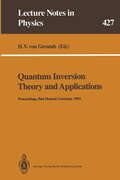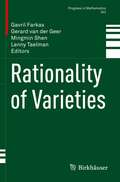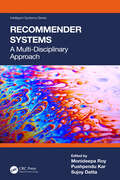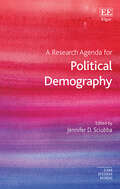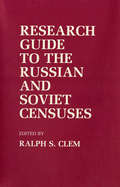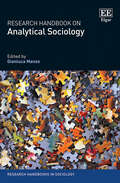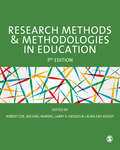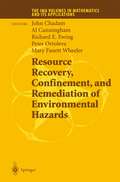- Table View
- List View
Proceedings of the 4th International Conference on New Computational Social Science (Advances in Social Science, Education and Humanities Research #844)
This is an open access book. Welcome to The 4th International Conference on New Computational Social Science which will be held on March 08-10, 2024, Shenzhen, Guangdong, China. The focus of this conference are mainly five aspects: Big data acquisition and analysis, Integration of qualitative research and quantitative research, Sociological Internet experiment research, Application of ABM simulation method in Sociology Research, Research and development of new social computing tools. With the rapid development of information technology, especially sweeping progress in the Internet of things, cloud computing, social networks, social media and big data. As a data-intensive science, social computing is an emerging thing that leverages the capacity to collect and analyze data with an unprecedented breadth, depth and scale. It represents a new computing paradigm and an interdisciplinary research and application field. A broad comprehension of major topics involved in social computing is important for both scholars and practitioners. This is an international conference on vary research aspects of Computational Social Science. We will present and discuss key concepts and analyze state-of-the-art of the field. The conference not only sheds insights on social computing, but also affords conduit for future research in the field. Social computing has two distinct trends: One is on the social science issues, such as computational social science, computational sociology, social network analysis, etc; The other is on the use of computational techniques, such as social use, hedonic use and generative use. Finally some new challenges ahead are summarized, including interdisciplinary cooperation and training, big data sharing for scientific data mashups, and privacy protect.
Proceedings of the 5th International Conference on Statistics, Mathematics, Teaching, and Research 2023 (Advances in Computer Science Research #109)
This is an open access book. There are still many other problems occur within the development of the science and frequently implemented that must be answered and discussed intensively to protect sacred goals of the science. Academic ambiance and spirits have to be returned as challenges keeps interfering within this digital development of the society. By this condition, the conference is an important step and expected to be a comprehensive pace in aligning various scientific problems and interests as the consequence of 5.0 era of society.International Conference on Statistics, Mathematics, Teaching, and Research (ICSMTR) 2023 is a conference for those who are interested in presenting papers in all fields of mathematics and statistics. This conference is a forum for discussion between various parties such as academicians, policy makers and social practitioners.
Proceedings of the 6th International Conference on Intelligent Computing (Advances in Computer Science Research #107)
This is an open access book. PECTEAM, being held for a period of two days, aims to witness the development of technologies in all technical and management domains. The major event in the conference is paper presentations on the latest advances in Engineering and Management disciplines from National and International academic sectors. Special emphasis is given to update newer technologies by Keynote speakers. PECTEAM is a premier platform for researchers and industry practitioners to share their new and innovative ideas, original research findings and practical development experiences in Engineering and Management through high quality peer reviewed papers.
Proceedings of the 7th Conference on Sound and Music Technology: Revised Selected Papers (Lecture Notes in Electrical Engineering #635)
The book presents selected papers that have been accepted at the seventh Conference on Sound and Music Technology (CSMT) in December 2019, held in Harbin, Hei Long Jiang, China. CSMT is a domestic conference focusing on audio processing and understanding with bias on music and acoustic signals. The primary aim of the conference is to promote the collaboration between art society and technical society in China. The organisers of CSMT hope the conference can serve as a platform for interdisciplinary research. In this proceeding, the paper included covers a wide range topic from speech, signal processing and music understanding, which demonstrates the target of CSMT merging arts and science research together.
Proceedings of the International Conference on Advances in Nano-Neuro-Bio-Quantum (Advances in Intelligent Systems Research #69)
This is an open access book. We are pleased to announce our Springer International Conference on Advances in Nano-Neuro-Bio-Quantum (I-CAN – 2023) which will be a unique conference where we will connect Biological Function through Computational sciences to the world of integrated quantum physics, chemistry, biology, medicine and therapeutics. The quantum science is seeking insights in Bioinformatics through quantum computing which again is an interdisciplinary filed linking quantum physics, chemistry and biology with computer science. Quantum computers achieve unprecedented calculating capabilities by harnessing the bizarre properties of matter on the subatomic scale, where electrons exist as clouds of probability and pairs of entangled particles can interact instantaneously, irrespective of their distance apart. But how far are we from fully realizing this new class of computers? What are its prospects to advance the study of artificial intelligence? And, when, if ever, will psychological scientists be able to write programs that unlock some of the secrets of human cognition? For now, a daunting list of technological innovations stands in the way of answering these questions. We can, however, take a glimpse at the current frontier of quantum computing and consider the technological gaps that remain. This science along with traditional Indian sciences coupled with big data and bioinformatics aims to unfold the complex relationship between genotype and phenotype on a global (genome-wide) scale to different biological processes. Quantum neurobiology is a concept to which we are not yet fully accustomed to: it refers to a narrow field of the operation of quantum physics in the nervous system such as the emergence of higher cognitive functions like consciousness, memory, internal experiences, and the processes of choice and decision-making which are products of the warm-wet-noisy brain. According to quantum neurobiology, quantum physics is involved in biological processes, and consciousness, memory, internal experiences, and the processes of choice and decision-making, which are the products of the warm-wet-noisy brain, may be the result of the operations of quantum physics.
Proceedings of the International Conference on Applied Sciences and Engineering (Atlantis Highlights in Engineering #22)
This is an open access book.We kindly welcome to all academicians, researchers, scientists, engineers and graduate students in the related fields to submit their original research papers. Applications in engineering science that require expertise in mathematics, physics and chemistry. Its mission is to become a voice of the applied science community, addressing researchers and practitioners in different areas ranging from mathematics, physics, and chemistry to all related braches of the engineering, presenting verifiable computational methods, findings, and solutions.The Conference provided a setting for discussing recent developments in various engineering and applied science topics, including Mathematics, Chemistry, Physics, Computational science, Material science, Environmental Science and Chemical engineering.The submitted conference papers will be subjected to stringent peer review and carefully evaluated based on originality and clarity of exposition. All the accepted papers will be published in the conference proceedings. The conference provides opportunities for the attendants to share new ideas, experiences in Applied Sciences and Engineering and to establish collaboration for the future.
Process Querying Methods
This book presents a framework for developing as well as a comprehensive collection of state-of-the-art process querying methods. Process querying combines concepts from Big Data and Process Modeling and Analysis with Business Process Intelligence and Process Analytics to study techniques for retrieving and manipulating models of real-world and envisioned processes to organize and extract process-related information for subsequent systematic use. The book comprises sixteen contributed chapters distributed over four parts and two auxiliary chapters. The auxiliary chapters by the editor provide an introduction to the area of process querying and a summary of the presented methods, techniques, and applications for process querying. The introductory chapter also examines a process querying framework. The contributed chapters present various process querying methods, including discussions on how they instantiate the framework components, thus supporting the comparison of the methods. The four parts are due to the distinctive features of the methods they include. The first three are devoted to querying event logs generated by IT-systems that support business processes at organizations, querying process designs captured in process models, and methods that address querying both event logs and process models. The methods in these three parts usually define a language for specifying process queries. The fourth part discusses methods that operate over inputs other than event logs and process models, e.g., streams of process events, or do not develop dedicated languages for specifying queries, e.g., methods for assessing process model similarity. This book is mainly intended for researchers. All the chapters in this book are contributed by active researchers in the research disciplines of business process management, process mining, and process querying. They describe state-of-the-art methods for process querying, discuss use cases of process querying, and suggest directions for future work for advancing the field. Yet, also other groups like business or data scientists and other professionals, lecturers, graduate students, and tool vendors will find relevant information for their distinctive needs.Chapter "Celonis PQL: A Query Language for Process Mining" is available open access under a Creative Commons Attribution 4.0 International License via link.springer.com.
Professionelles Handeln im fachfremd erteilten Mathematikunterricht: Empirische Befunde und Fortbildungskonzepte
Der vorliegende Band umfasst Beiträge von Expertinnen und Experten verschiedener Disziplinen zum fachfremd erteilten Mathematikunterricht in Deutschland. Präsentiert werden neben Überblicks- und Diskussionsbeiträgen aktuelle Forschungsbefunde zum Quer- bzw. Seiteneinstieg und zu fachfremd tätigen Lehrkräften sowie Konzepte der Lehrerfortbildung im Fach Mathematik.Die Herausgeberinnen: PD Dr. Raphaela Porsch ist Akademische Rätin am Institut für Erziehungswissenschaft im Arbeitsbereich „Schulpädagogik/Schul- und Unterrichtsforschung“ der Westfälischen Wilhelms-Universität Münster. Prof. Dr. Bettina Rösken-Winter ist Professorin am Institut für Erziehungswissenschaften der Humboldt-Universität zu Berlin mit dem Schwerpunkt „Mathematik für die Primarstufe“.
Public Pension Economics (Journal of Economics Zeitschrift für Nationalökonomie Supplementum #7)
Recent years have witnessed a growing unease about using government deficits to measure fiscal policy. Martin Feldstein (1974) pointed out that vast amounts of unfunded Social Security retirement liabilities are not picked up in official debt figures. The 1982 Economic Report of the President and Leonard (1987) stressed the same is true of unfunded civil service and military pensions and a range of other programs such as FSLIC commitments, etc. Eisner and Pieper (1984, 1985), Boskin (1987), and Boskin, Robinson, and Huber (1987) fault the official U. S. deficit for ignoring government assets. These and a host of related complaints about conventional deficit accounting coincided with demonstrations by Kotlikoff (1979), Summers (1981), Charnley (1981), Auerbach and Ko tlikoff (1983) and others that 1) major intergenerationally-redistributive fiscal policies can be conducted under the guise of a "balanced budget" and 2) identical fiscal policies can be conducted concomitant with dra matically different time paths of reported deficits. While some economists, including Eisner and Pieper (1983, 1985) and Leonard (1987) suggest that the deficit can be fixed, the arbitrary nature of such corrections raises the question of whether the deficit is a well-defined economic concept. Unfortunately, it is not. In a series of articles (Kotlikoff 1984, 1986, 1988) I have pointed out that from a neoclassical perspective the deficit is an arbitrary accounting construct with no necessary relation ship to the fundamental stance of fiscal policy.
Qualität bei zusammengeführten Daten: Befragungsdaten, administrative Daten, neue digitale Daten: miteinander besser? (Schriftenreihe der ASI - Arbeitsgemeinschaft Sozialwissenschaftlicher Institute)
Die Zusammenführung von Daten aus verschiedenen Quellen eröffnet der akademischen Sozialforschung, der Marktforschung wie auch der amtlichen Statistik vielversprechende Chancen. Das Buch gibt einen Überblick über aktuelle Anwendungen der Datenzusammenführung in den verschiedenen Bereichen sowie über die damit verbundenen Chancen und Risiken.
Quantum Inversion Theory and Applications: Proceedings of the 109th W.E. Heraeus Seminar Held at Bad Honnef, Germany, May 17–19, 1993 (Lecture Notes in Physics #427)
This volume covers aspects of Schr|dinger equation inversion for the purposeof determining interaction potentials in particle, nuclear and atomic physics from experimental data. It includes reviews and reports on the latest developments in mathematics, supersymmetric quantum mechanics, inversion for fixed-l nucleon-nucleon potentials, inversion of fixed-E optical potentials and their generalizations. Also included are some topics on nonlinear differential equations relating to theSchr|dinger or other equations of particle, nuclear, atomic and molecular physics which can be solved by inverse scattering transformations. The material collected in this volume gives a clear picture of the status ofresearch in this rapidly growing field. The book addresses students and young scientists as well as researchers in theoretical physics and functional analysis.
Rationality of Varieties (Progress in Mathematics #342)
This book provides an overview of the latest progress on rationality questions in algebraic geometry. It discusses new developments such as universal triviality of the Chow group of zero cycles, various aspects of stable birationality, cubic and Fano fourfolds, rationality of moduli spaces and birational invariants of group actions on varieties, contributed by the foremost experts in their fields. The question of whether an algebraic variety can be parametrized by rational functions of as many variables as its dimension has a long history and played an important role in the history of algebraic geometry. Recent developments in algebraic geometry have made this question again a focal point of research and formed the impetus to organize a conference in the series of conferences on the island of Schiermonnikoog. The book follows in the tradition of earlier volumes, which originated from conferences on the islands Texel and Schiermonnikoog.
Recommender Systems: A Multi-Disciplinary Approach (Intelligent Systems)
Recommender Systems: A Multi-Disciplinary Approach presents a multi-disciplinary approach for the development of recommender systems. It explains different types of pertinent algorithms with their comparative analysis and their role for different applications. This book explains the big data behind recommender systems, the marketing benefits, how to make good decision support systems, the role of machine learning and artificial networks, and the statistical models with two case studies. It shows how to design attack resistant and trust-centric recommender systems for applications dealing with sensitive data. Features of this book: Identifies and describes recommender systems for practical uses Describes how to design, train, and evaluate a recommendation algorithm Explains migration from a recommendation model to a live system with users Describes utilization of the data collected from a recommender system to understand the user preferences Addresses the security aspects and ways to deal with possible attacks to build a robust system This book is aimed at researchers and graduate students in computer science, electronics and communication engineering, mathematical science, and data science.
Reflection
This diagram shows a triangle reflected on two different mirror lines. A locator dot and title are shown. These must always be at the top left of the page when the image is the right way up. There is a graph with all four quadrants showing, and the x and y axes ranging from -3 to 3. The x and the y axis intersect at the origin O. Positive values are to the right and to the top of the diagram. Negative values are to the left and to the bottom of the diagram. Not all axis division marks are labelled. Some of the braille uses maths code notation. When a shape is reflected it is the same shape but turned over into a new position. The original triangle 1 is in the top left quadrant. Triangle 2 to the right is a reflection in the y-axis. The mirror line is represented by a heavy dashed line which has replaced the normal y axis line in the top part of the diagram. Triangle 3 in the bottom right quadrant, is a reflection in the y = x-axis. This mirror line is also shown as a heavy dashed line. Note the two mirror lines would normally go from one edge of the graph to the other, in this diagram the mirror lines have been shortened to prevent tactile confusion.
Reflection
This diagram shows a triangle reflected on two different mirror lines. A locator dot and title are shown. These must always be at the top left of the page when the image is the right way up. There is a graph with all four quadrants showing, and the x and y axes ranging from -3 to 3. The x and the y axis intersect at the origin O. Positive values are to the right and to the top of the diagram. Negative values are to the left and to the bottom of the diagram. Not all axis division marks are labelled. Some of the braille uses maths code notation. When a shape is reflected it is the same shape but turned over into a new position. The original triangle 1 is in the top left quadrant. Triangle 2 to the right is a reflection in the y-axis. The mirror line is represented by a heavy dashed line which has replaced the normal y axis line in the top part of the diagram. Triangle 3 in the bottom right quadrant, is a reflection in the y = x-axis. This mirror line is also shown as a heavy dashed line. Note the two mirror lines would normally go from one edge of the graph to the other, in this diagram the mirror lines have been shortened to prevent tactile confusion.
Reflection
This diagram shows a triangle reflected on two different mirror lines. A locator dot and title are shown. These must always be at the top left of the page when the image is the right way up. There is a graph with all four quadrants showing, and the x and y axes ranging from -3 to 3. The x and the y axis intersect at the origin O. Positive values are to the right and to the top of the diagram. Negative values are to the left and to the bottom of the diagram. Not all axis division marks are labelled. Some of the braille uses maths code notation. When a shape is reflected it is the same shape but turned over into a new position. The original triangle 1 is in the top left quadrant. Triangle 2 to the right is a reflection in the y-axis. The mirror line is represented by a heavy dashed line which has replaced the normal y axis line in the top part of the diagram. Triangle 3 in the bottom right quadrant, is a reflection in the y = x-axis. This mirror line is also shown as a heavy dashed line. Note the two mirror lines would normally go from one edge of the graph to the other, in this diagram the mirror lines have been shortened to prevent tactile confusion.
A Research Agenda for Political Demography (Elgar Research Agendas)
Elgar Research Agendas outline the future of research in a given area. Leading scholars are given the space to explore their subject in provocative ways, and map out the potential directions of travel. They are relevant but also visionary.Exploring how demographic dynamism continues to shape the character of societies, this forward-looking Research Agenda offers insights into how the human population has undergone fundamental demographic shifts, and the impact these have had on how we organize ourselves politically, the design of our economic systems, and even our societal relationships.The Research Agenda first introduces readers to the foundations of demographic change: fertility, mortality and migration. Chapters examine the political impact of forced migration, urbanization, gender dynamics, the intersection of race, identity and electoral politics, religious and ethnic groups, and health. The implications of the geographic shift in population centres from the Global North to the Global South are also highlighted, as well as the relationship between demography on the one hand and political and economic power on the other.This will be an invigorating read for social science scholars looking to develop their research or interact with current research trends, particularly scholars of human geography, development studies and geopolitics.
Research Guide to the Russian and Soviet Censuses (Studies in Soviet History and Society)
Taken together, the Russian census of 1897 and the Soviet censuses of 1926, 1959, 1970, and 1979 constitute the largest collection of empirical data available on that country, but until the publication of this book in 1986, the daunting complexity of that material prevented Western scholars from exploiting the censuses fully. This book is both a guide to the use of and a detailed index to these censuses. The first part of the book consists of eight essays by specialist on the USSR, six of them dealing with the use of census materials and the availability of data for research on ethnicity and language, marriage and the family, education and literacy, migration and organization, age structure, and occupations. The second part, a comprehensive index for all the published census, presents more than six hundred annotated entries for the census tables, a keyword index that enables researchers to find census data by subject, and a list of political-administrative units covered in each census.
Research Handbook on Analytical Sociology (Research Handbooks in Sociology series)
Providing an up-to-date portrait of the concepts and methods of analytical sociology, this pivotal Research Handbook traces the historical evolution of the field, utilising key research examples to illustrate its core principles. It investigates how analytical sociology engages with other approaches such as analytical philosophy, structural individualism, social stratification research, complexity science, pragmatism, and critical realism, exploring the foundations of the field as well as its major explanatory mechanisms and methods.Chapters examine the ways in which analytical sociology addresses crucial concepts, including norms, structures, context, contingency, action theory, and models of social interactions. Offering an in-depth analysis of cumulative advantage, complex contagions, and network amplification, this comprehensive Research Handbook discusses the range of data sources and methods available to analytical sociologists for empirical research, in particular digital traces, historical archives, game-theoretic models, causal inference techniques, social networks analysis, and agent-based simulations.Creating a new synthesis of the theoretical and methodological resources required to carry out research using analytical sociology tools, the Research Handbook will be a key pedagogical resource for students and scholars of sociology and sociological theory, research methods, demography, social psychology, economics, and computer science.
Research Methods and Methodologies in Education
Your #1 resource for carrying out educational research as part of postgraduate study. High-quality educational research requires careful consideration of every aspect of the process. This all-encompassing textbook written by leading international experts gives you considered overview of principles that underpin research, and key qualitative, quantitative and mixed methods for research design, data collection and analysis. This third edition includes four new chapters: Disseminating your research Data science and computational research methods Observational methods Analysis of variance (ANOVA) Plus a new Research essentials feature that highlights key ‘must-haves’ or misconceptions relating to each methodological approach, research design or analytical tool discussed. This is essential reading for postgraduate students on education courses and early career researchers looking to sharpen their research practice.
Resource Recovery, Confinement, and Remediation of Environmental Hazards (The IMA Volumes in Mathematics and its Applications #131)
This IMA Volume in Mathematics and its Applications RESOURCE RECOVERY, CONFINEMENT, AND REMEDIATION OF ENVIRONMENTAL HAZARDS contains papers presented at two successful one-week workshops: Confine ment and Remediation of Environmental Hazards held on January 15-19, 2000 and Resource Recovery, February 9-13, 2000. Both workshops were integral parts of the IMA annual program on Mathematics in Reactive Flow and Transport Phenomena, 1999-2000. We would like to thank John Chadam (University of Pittsburgh), Al Cunningham (Montana State Uni versity), Richard E. Ewing (Texas A&M University), Peter Ortoleva (In diana University), and Mary Fanett Wheeler (TICAM, The University of Texas at Austin) for their excellent work as organizers of the meetings and for editing the proceedings. We take this opportunity to thank the National Science Foundation for their support of the IMA. Series Editors Douglas N. Arnold, Director of the IMA Fadil Santosa, Deputy Director of the IMA v PREFACE Advances in resource recovery, and confinement/remediation of envi ronmental hazards requires a coordinated, interdisciplinary effort involving mathematicians, scientists and engineers. The intent of this collection of papers is to summarize recent theoretical, computational, and experimen tal advances in the theory of phenomena in porous media, with the intent to identify similarities and differences concerning applications related to both resource recovery and confinement and remediation of environmental hazards.
Rotation
This diagram shows three triangles; the original triangle and its rotation in two different directions to two new positions. A locator dot and title are shown. These must always be at the top left of the page when the image is the right way up. There is a graph with all four quadrants showing, and the x and y axes ranging from -3 to 3. The x and the y axes intersect at the origin marked by an X. Axes values are positive to the right and to the top of the diagram. Axes values are negative to the left and to the bottom of the diagram. Not all axis division marks are labelled. Some of the braille uses maths code notation. When an object is rotated it stays the same shape but its position and orientation change. The original triangle is in the top left quadrant. The triangle rotated 90? clockwise is to the right. The triangle rotated 180? anticlockwise is shown in the bottom right quadrant. Their path of movement is indicated by curved heavy dashed arc lines. Note the 90? arc in the top right quadrant is broken in the tactile version of the graph to allow a braille label to be clearly read.
Rotation
This diagram shows three triangles; the original triangle and its rotation in two different directions to two new positions. A locator dot and title are shown. These must always be at the top left of the page when the image is the right way up. There is a graph with all four quadrants showing, and the x and y axes ranging from -3 to 3. The x and the y axes intersect at the origin marked by an X. Axes values are positive to the right and to the top of the diagram. Axes values are negative to the left and to the bottom of the diagram. Not all axis division marks are labelled. Some of the braille uses maths code notation. When an object is rotated it stays the same shape but its position and orientation change. The original triangle is in the top left quadrant. The triangle rotated 90? clockwise is to the right. The triangle rotated 180? anticlockwise is shown in the bottom right quadrant. Their path of movement is indicated by curved heavy dashed arc lines. Note the 90? arc in the top right quadrant is broken in the tactile version of the graph to allow a braille label to be clearly read.
Rotation
This diagram shows three triangles; the original triangle and its rotation in two different directions to two new positions. A locator dot and title are shown. These must always be at the top left of the page when the image is the right way up. There is a graph with all four quadrants showing, and the x and y axes ranging from -3 to 3. The x and the y axes intersect at the origin marked by an X. Axes values are positive to the right and to the top of the diagram. Axes values are negative to the left and to the bottom of the diagram. Not all axis division marks are labelled. Some of the braille uses maths code notation. When an object is rotated it stays the same shape but its position and orientation change. The original triangle is in the top left quadrant. The triangle rotated 90? clockwise is to the right. The triangle rotated 180? anticlockwise is shown in the bottom right quadrant. Their path of movement is indicated by curved heavy dashed arc lines. Note the 90? arc in the top right quadrant is broken in the tactile version of the graph to allow a braille label to be clearly read.
